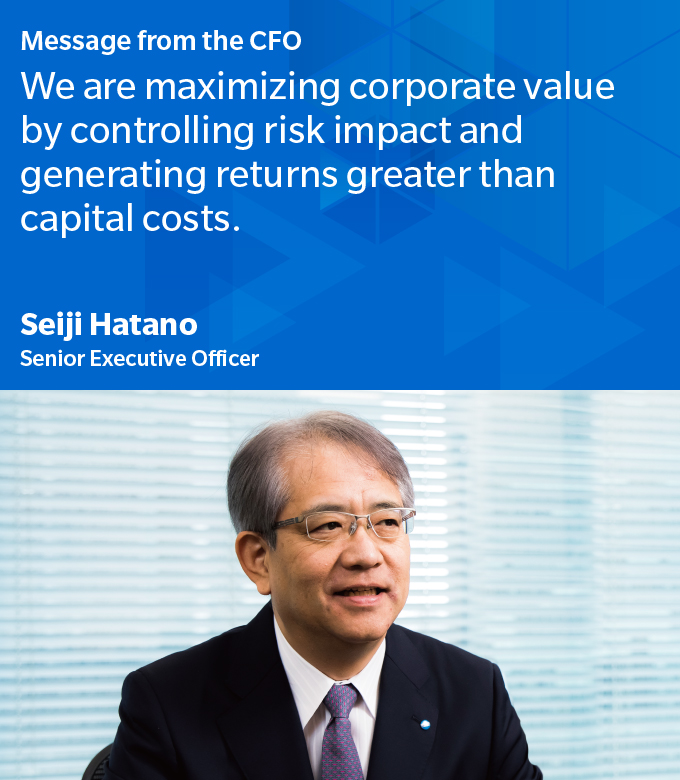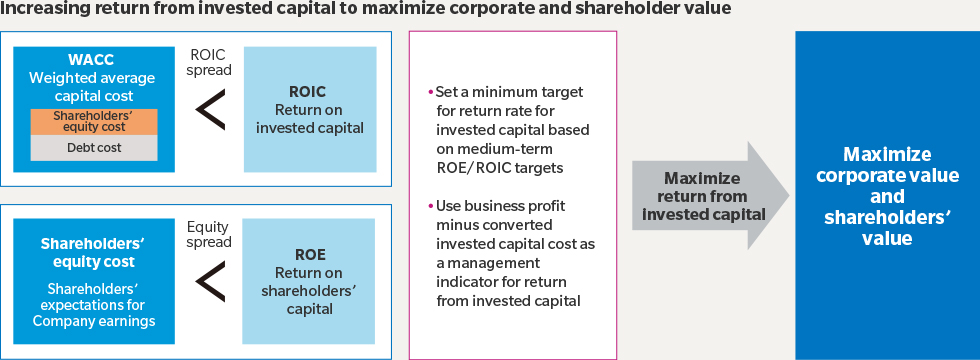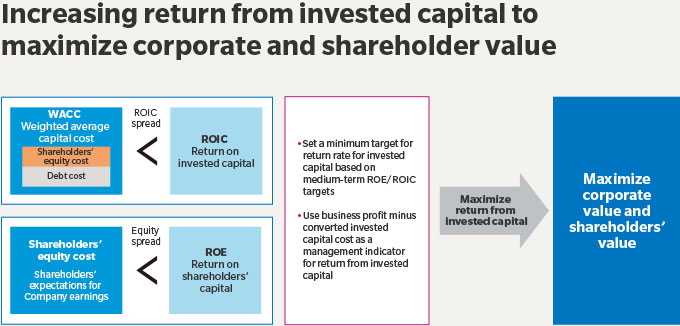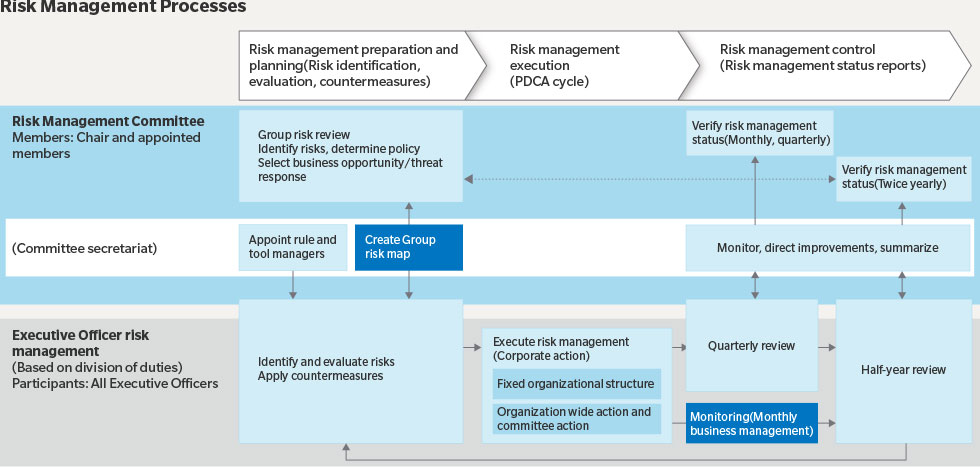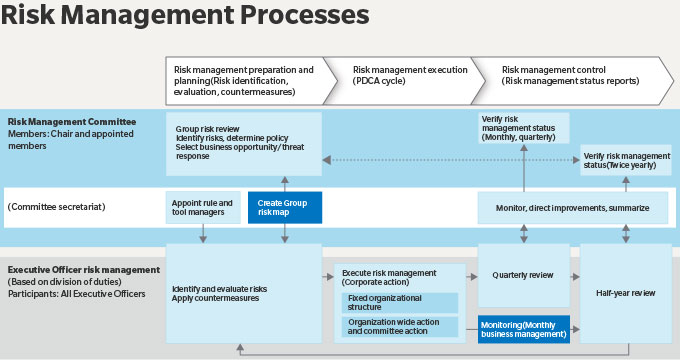Management focused on cost of capital Q1. What is the Company's policy and strategy for increasing capital efficiency?
Konica Minolta is transforming into a digital company with insight into implicit challenges through aggressive upfront investment in new and growth business areas for the medium and long term and by reformulating its business portfolio to boost capital efficiency. In fiscal 2018, the Company raised ROE by 1.6 points to 7.7%.
Management has two top priorities for raising the profit margin and ROE. The first is to create new value for the Company and increase customer value by guiding our M&A, R&D spending, capital investment, and other upfront investments to fruition and accelerating the growth of our Workplace Hub, Bio-Healthcare, Industrial Printing, and other new and growth businesses. The second is to bolster our core businesses by introducing new products to expand our market share and continuing with cost reform to steadily improve our earning power.
In the new and growth businesses, our focus is on generating sales as well as strengthening our management of key performance indicators (KPI) in categories like the number of customers and sales per customer that directly link to sales growth. We have been steadily improving the performance of our core businesses, but we believe we can increase the profit margin by further improving productivity and working capital.
Q2. Specifically, how will you improve capital efficiency?
There are three basic ways to raise ROE, specifically increasing the profit margin, using assets efficiently (total assets turnover ratio), and leveraging debt. We are focusing mainly on the profit margin and how we use our assets because these enable measures that will directly impact our business. We are improving both of these by strengthening the management of our business portfolio to maximize return on invested capital (ROIC) and return from invested capital with the aim of enhancing our corporate value.
We are diligently managing the ROIC and return from invested capital of each business, particularly our core businesses, to generate returns exceeding cost of capital (the weighted average cost of capital (WACC)), while also revising and reformulating our business portfolio to improve capital efficiency strengthening. We are also improving capital efficiency by optimizing the cash conversion cycle, such as by reducing inventory volumes, regularly reviewing capital expenditure and investment and loans, and stepping up business selection and concentration for each business.
We will apply this approach to return from invested capital not only to our business administration but also to evaluate business results and the soundness of the management at our subsidiary firms with the aim of providing additional motivation to for our businesses and subsidiaries to improve their performance results.
In taking this management approach, my main emphasis is on strengthening our on-site capabilities. I believe the best way for us to increase our return from invested capital is not to take the typical approach described in finance textbooks but to link it to the daily actions of all employees at our work sites because this is directly connected to the qualitative strengthening of our corporate capabilities. In fiscal 2019, I will work to deepen the connections between our business divisions and corporate departments and accelerate our companywide effort to increase return from invested capital by setting targets, creating mechanisms, increasing employee understanding and motivation.
Through these measures, we will increase the ROIC-WACC spread and the equity spread (ROE to shareholders' equity cost) to maximize our corporate value and shareholder value.
*Return from invested capital is business profit minus invested capital multiplied by the capital cost ratio. This indicates the amount that value exceeds the cost of capital.
Allocation of Profit to Investment and Shareholder Return Q3. How will you allocate profit to growth investment and shareholder return?
Our basic capital policy is to maintain a solid financial base while aggressively investing for business growth to transform our business model, As we do this, we will continue providing ample shareholder return, maintain our management focus on cost of capital, and strengthen our business portfolio management to continue improving our capital efficiency and increase our corporate value in the medium and long term.
We will focus particularly on generating operating cash flow by revising our business composition, enhancing the earning power of our core businesses, and improving the efficiency of working capital. We will also use effective capital expenditure, investment, and investment and loans to maximize free cash flow, which we will allocate to enhancing shareholder return and fortifying the financial base.
In fiscal 2019, we plan to increase operating cash flow by over ¥25.0 billion year on year to ¥85.0 billion by building up profits and improving working capital. We anticipate investment cash flow of ¥60.0 billion (excluding investment and loans) and free cash flow of ¥25.0 billion. We plan to return roughly half of the free cash flow we generate to shareholders. We will continue to base our investment decisions on the state of world affairs, market conditions, our business growth potential, and returns after capital costs as we seek to improve capital efficiency, maximize free cash flow, and return profits to shareholders.
Q4. What is the progress and plan for capital expenditure and investment and loans?
Capital expenditure amounted to ¥52.5 billion in fiscal 2018. Investments mainly focused on developing new products and expanding production capacity in the core Office Business, Professional Print Business, and Industrial Business. Investment and loans amounted to ¥14.0 billion with a large part used to acquire distributors in France to expand and strengthen direct sales channels and the customer base for multifunction peripherals (MFP), and to prepare for development of the Workplace Hub operation. The Company used its own capital for all of these investments.
In fiscal 2019, we are planning ¥60.0 billion in capital expenditure to be focused again on the core Office Business, Professional Print Business, and Industrial Business. We plan to augment production facilities and advance new product development, optimize our development and production operations for the global market as we accelerate our digital transformation, concentrate and consolidate our dispersed development and production functions within Japan, and further enhance the high value-added in our businesses. We are additionally planning strategic investments to construct a new R&D center in the Kansai area to boost our imaging IoT development capabilities and to make our domestic operating sites more effective and efficient.
We are allocating ¥20.0 billion for investment and loans to advance growth strategies, particularly related to the bio-healthcare business and the visual inspection field in the measuring instruments business.
Q5. What is the Company's dividend policy?
Konica Minolta's dividend payout policy is to proactively return profits to shareholders while taking into consideration the overall status of consolidated earnings and strategic investment in growth fields. Management enhance shareholder return by increasing the dividend payout amount and flexibly conducting share buyback programs.
In fiscal 2018, the Company distributed cash dividends of ¥30 per share, for a payout ratio of 35.6%. Management plans to maintain the dividend payment at ¥30 in fiscal 2019, for an expected payout ratio of 39.6%. The Company has maintained the dividend payout ratio within 30-40% for the past several years and will continue seeking to supplement shareholder return through additional measures, including share buybacks at levels matched to cash flow and dividend.
Risk Awareness and Prevention Q6. Please describe your risk management structure and processes.
We view risk as uncertainties that have the potential to impact the profits and losses of our organization. We apply risk management not only on the negative side where it could cause losses, but also on the positive side for the sources of our earnings. Our risk management encompasses controlling the negative impact while also maximizing return.
The Risk Management Committee works to structure and help strengthen the risk management of all Group companies. The members of the Risk Management Committee, on which I serve as the chair, are selected Executive Officers and individuals in higher positions. The committee members are appointed by the chair and are responsible for the risk management for their departments.
The committee meets twice yearly to carefully review management risk items in each of the 17 categories, including items classified as small and medium risks. The committee conducts monthly and quarterly monitoring, reviews the status of countermeasures, and applies the PDCA process to improve the risk measures.
The Risk Management Committee also annually identifies specific material risks to the Group that it deems especially critical to management and takes direct management responsibility for risks considered important to monitor from a companywide perspective. The committee chair appoints committee members (Executive Officers) to lead the risk management of these items and to monitor the monthly progress of the Group's countermeasures.
All risks are plotted based on quantitative assessments of their potential degree of impact and occurrence frequency into a comprehensive Group Risk Map. These maps are updated and pertinent countermeasures discussed twice a year with the committee chair convening the committee as deemed necessary.
Q7. What are the major risks to the Group in fiscal 2019, and what are your countermeasures?
The major risks the Risk Management Committee has identified for fiscal 2018 and 2019 are uncertainty concerning the US government in terms of foreign relations, foreign trade, and financial policy; rising protectionism and trade issues; and uncertainty concerning the situation of the European Union, specifically Brexit.
We are monitoring the risks and taking necessary actions related to the trade friction and trade sanctions between the United States and China, the direction of trade relations between the countries, and regulations and sanctions arising from U.S. National Defense Authorization Act. We are also closely monitoring and preparing responses for the potential impact of Brexit on the EU, which is a core market for the Company. We have already begun fortifying our business structure for any eventuality and potential impact on our business there.
In addition, cognizant of risks being faced by other Japanese companies, we have set critical risk management categories including fraud risk at overseas subsidiaries, quality issues, client data leaks, labor issues, and cyber security.
The Risk Management Committee also annually reviews its assessments of major risks for Group management in terms of ESG and the Company's medium- and long-term vision, and updating a Group Risk Map of the sources of each risk.
The Company also approaches risk from another angle. We also conduct risk management activities to lead to positive actions in response to new developments in society. For example, while considering the potential future risk that 5G technology may pose to our businesses, we also examine companywide potential for early action to lead to new value-added activities and business opportunities.
Our crisis management includes strict reporting rules for when a crisis occurs to inform Executive Officers, Officers of subsidiaries, and others and to ensure a prompt and appropriate response. The rules stipulate that an Executive Officer for crisis management be appointed for centralized management for collecting and responding to information about disasters and other crisis events worldwide.
Our risk management structure is designed to facilitate efficient and effective management of various risks to earnings from the short-, medium-, and long-term perspectives to ensure our ability to continuously enhance corporate value.


